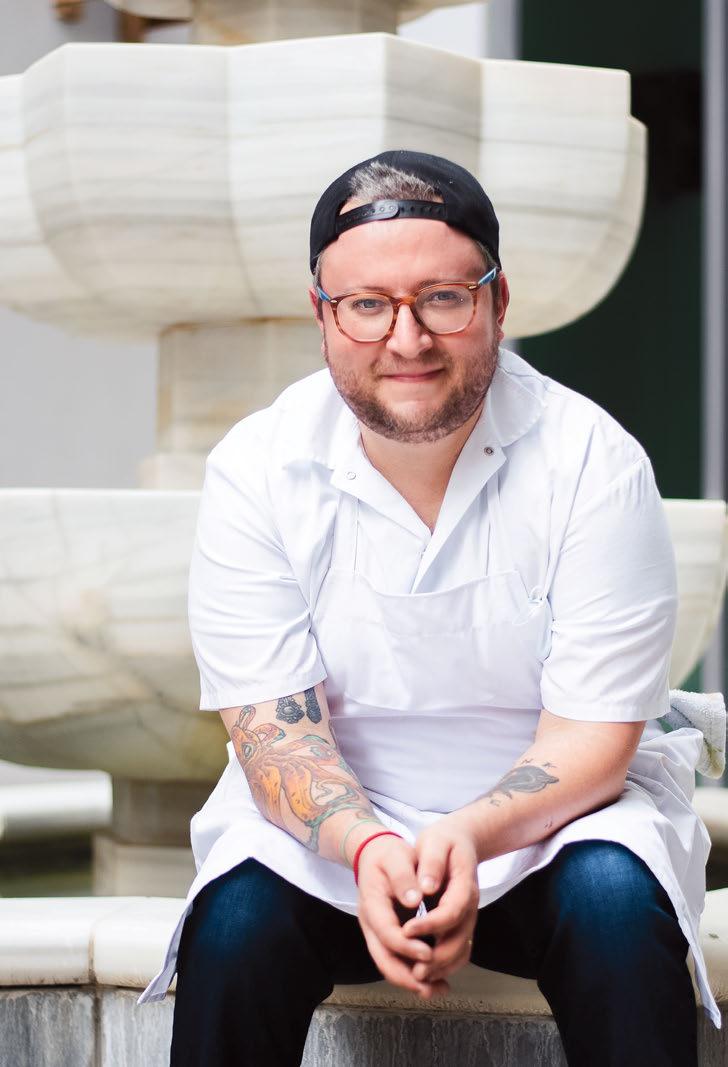
8 minute read
PABLO ZITZMANN
e day after graduation from Academia de Cocina Verde Oliva culinary school in Bogota, Colombia, Pablo Zitzmann moved to live with his dad in Miami—his rst step in a culinary career that would take him all over the world. Aside from working as a dishwasher/tortilla-maker at age 14, his rst restaurant job was as a line cook at Señora Martínez by Michelle Bernstein, then Nobu under Chef omas Buckley. Zitzmann staged around NYC before landing the sous gig at Matador Room and Market at EDITION by Jean-Georges Vongerichten.
Interested in Asian cuisine, Zitzmann traveled to Hawaii in 2013 to stage at e Pig and the Lady in Honolulu’s Chinatown. From there, he moved on to Royal Garden Chinese Restaurant in Honolulu and Yardbird in Hong Kong. When he was ready to return to Miami in 2014, he opened the 75-seat No Name Chinese in South Miami as executive chef. e restaurant drew praise from local media but closed in 2019, and Zitzmann took an executive chef position at the THesis Hotel. When the coronavirus crippled the hotel industry, he launched his own business, Zitz Sum, a tribute to his nickname and love of dim sum. He was cooking out of his home and selling through Instagram until January, when the owner of a space in Coral Gables approached him about opening there. So in early 2021, Zitzmann’s dumplings found a kitchen of their own.
Advertisement
ZITZ SUM
pablozitzmann / zitzsum
Favorite kitchen tool: Cake tester and cast-iron pan Tool you wish you had: Rational oven Favorite cookbook: Night + Market by Kris Yenbamroong and Garrett Snyder. Fantastic stories, great wine pairings. Most important kitchen rule: Be respectful and mindful. Place to visit for culinary travel: NYC What you eat on your nights o : I love Itamae and Ariete. Both are Miami’s culinary driving forces and inspiration sources for me. Great people, good friends.

Hakurei turnips, málà vinaigrett e, tofu, labneh, lemon balm
Chef Pablo Zitzmann of Zitz Sum Adapted by StarChefs Yield: 1 serving
METHOD
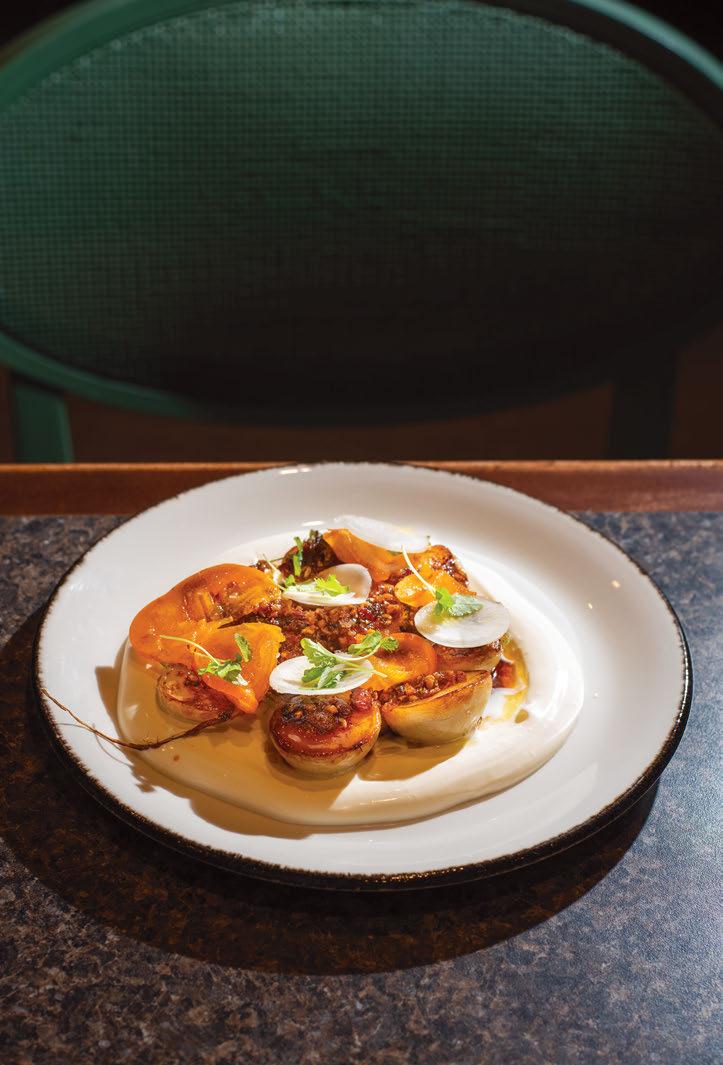
For the Turnips:
In salted boiling water, blanch turnips approximately 2 minutes. Using a cake tester or the tip of a knife, test for doneness. ( ey should be al dente.) Immediately shock turnips in ice water bath and transfer to a sheet tray lined with paper towels. Dry the turnips well; reserve.
For the Málà Vinaigrette:
In a saucepot, heat sesame oil. Add sugar and melt. Bring to a simmer and continue to cook until oil reaches 235°F. Slowly add garlic, ginger, and Szechuan and whisk carefully. Cook 3 minutes until garlic is caramelized. Lower the heat, add soy sauce, vinegar, and 65 grams water and whisk until fully incorporated. Bring to a simmer and continue to simmer 3 to 4 minutes. Remove from heat, add chile crisp, and let cool to room temperature.
For the Whipped Labneh Tofu:
In a Vitamix blender at low speed, blend tofu, labneh, and yuzu salt. Once puréed, increase the speed, add oils, and emulsify. Transfer to a nonreactive container and refrigerate at least 2 hours. INGREDIENTS
Turnips:
Salt 1 bunch Hakurei or baby turnips, vertically halved
Málà Vinaigrette:
55.5 grams Kikkoman sesame oil 63 grams white sugar 100 grams chopped garlic 80 grams grated ginger 18 grams ground Szechuan peppercorns 80 grams Kikkoman soy sauce 200 grams chinkiang vinegar 40 grams chile crisp
Whipped Labneh Tofu:
180 grams rm tofu, drained and patted dry 60 grams labneh 6 grams yuzu salt 55 grams extra virgin olive oil 10 grams Kikkoman sesame oil
To Assemble and Serve:
Salt Freshly ground green
Szechuan peppercorns Sliced chives inly sliced persimmons Extra virgin olive oil Fresh Origins micro lemon balm Fresh Origins micro shiso bicolor Shaved raw turnips
To Assemble and Serve:
Season Turnips with salt and Szechuan. On a hot at-top or sauté pan, roast Turnips at-side-down until golden brown. Transfer to a bowl and drizzle with a few tablespoons Málà Vinaigrette and a dash of Whipped Labneh Tofu. Mix, then add chives.
Spoon a generous dollop of Whipped Labneh Tofu onto a serving plate and, using the back of the spoon, spread it out evenly through the center of the plate. Place roasted Turnips roasted-side-up, one next to the other. Spoon remaining Málà Vinaigrette over the Turnips. Garnish with persimmons and drizzle with olive oil. Finish with lemon balm, shiso bicolor, and raw turnips.
Featured ingredients: Kikkoman soy sauce and sesame oil, Fresh Origins micro lemon balm and micro shiso bicolor Featured equipment: Vitamix Commercial blender
When Hurricane Maria struck Puerto Rico, Chef Karla Hoyos used her corporate catering experience to lead disaster relief operations through World Central Kitchen. Impressed by Hoyos, co-founder José Andrés o ered her a position as chef de cuisine at e Bazaar by José Andrés Miami. Since she accepted the job, Hoyos has also been on the front lines of WCK e orts in the Bahamas, Spain, and Miami. We spoke with Hoyos about her role in disaster relief and what her colleagues refer to as e Karla System.
How did you rst become involved in community work?
In 2010, there was a huge hurricane in my hometown in Veracruz. My family and I—since I had a catering business— brought a lot of equipment. And I just started cooking at the shelter for people. It was 200 people a day, but I was a culinary student, and for me, that was a lot.
What was it like to be in Spain during the pandemic
last year? One day, you would have ve volunteers arrive; another day, you would have 20, but you need to make the same amount of food. is kitchen was on the second oor, and the elevator would break. So we made human chains to bring all the purchases up and all the food down. We started making 950 meals a day. By the third week, we were making 14,000 a day.
What memories come to mind when you think about
your time in disaster relief? During Hurricane Maria, we were some of the rst ones to this island. We’d ll [the World Central Kitchen private charter] up with food, supplies, a couple of solar water lters. When we got there, people didn't even know what time it was. One of the ladies was like, "We just haven't eaten in days. ere's people that don't have water." It was shocking to see. e kids were soaking the humidity from the dirt because they were so thirsty. In Spain, I broke down. I'm not gonna lie. We went to this area in Madrid. I remember this girl. She was like 14 years old. She had no shoes. We gave her food, and she ate the sandwich super fast. And then she stood up for only ve minutes. I had to go to the car, and I was like, "I can't. I can't."
What is e Karla System?
I'm very methodical in how we do things depending on the equipment that we have to make sure we are as e cient as possible. Every single situation, every single kitchen is di erent. In Spain, the method was that somebody was cooking all the proteins, somebody was cooking all the veggies, and somebody was cooking all the starch. You need to create systems that people can repeat easily. Because if you do a lot of steps, people get confused. It needs to be very e cient, very practical, and fast.
How has José Andrés mentored you in this area?
He remembers everything he promises, and when you're working side by side, he thinks of everything. I've seen him almost fainting but trying to help. He just cares. Makes you want to do more.
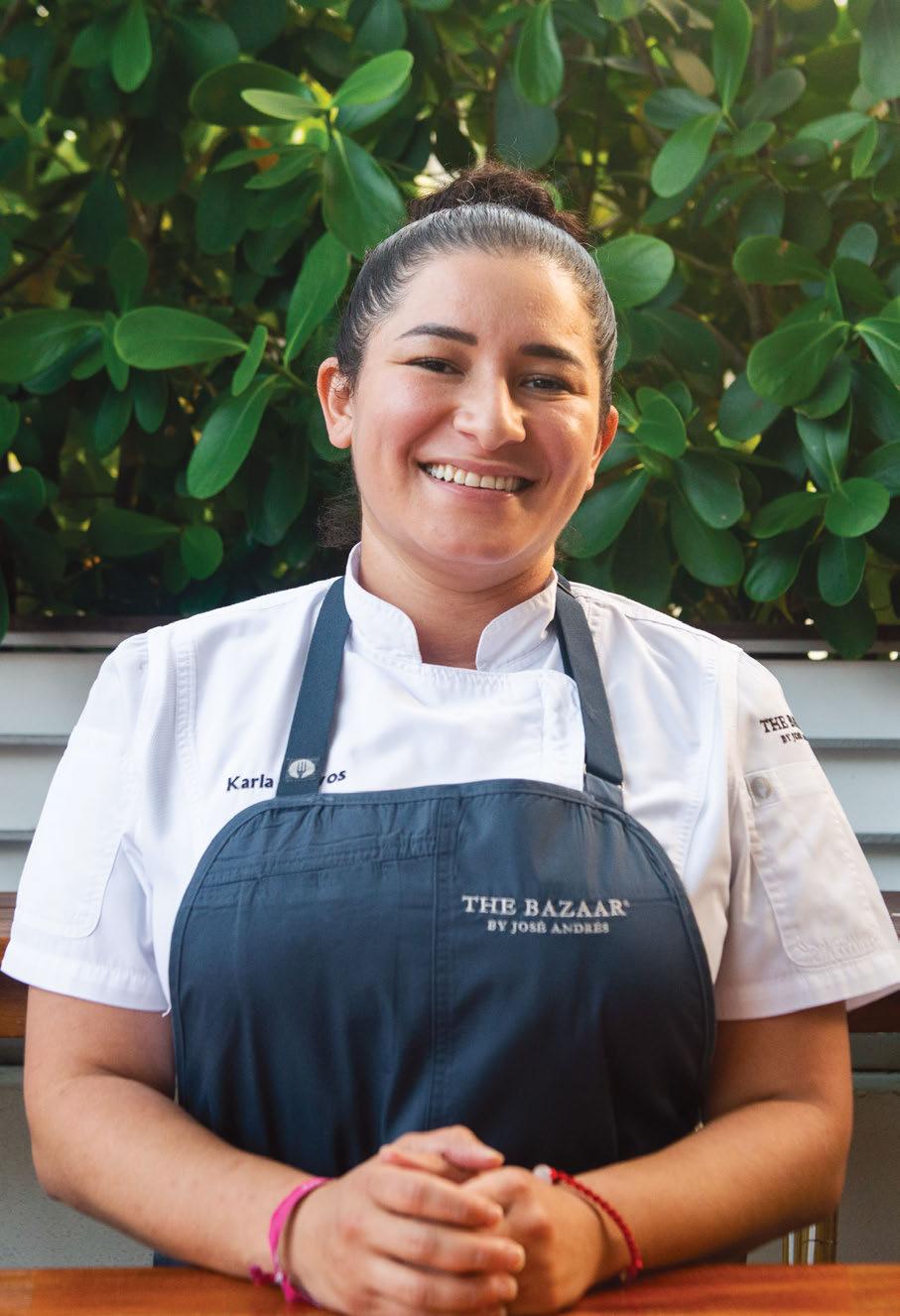
The Karla
the karla system by aiman javed
What’s something you wish people knew about being a chef
in disaster relief? It's not for everyone. If you don't make it on a disaster relief operation, it's your responsibility that families are not going to be eating that day. And that's a di erent kind of pressure. e stress, oh my God, I cannot even explain. But you want to help. at joy, you can't compare it to anything.
what's in the box?✿
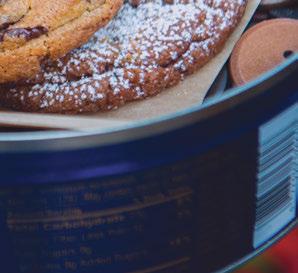
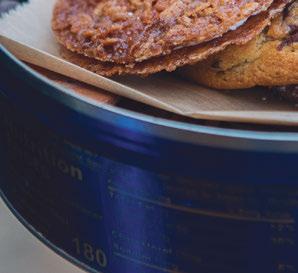
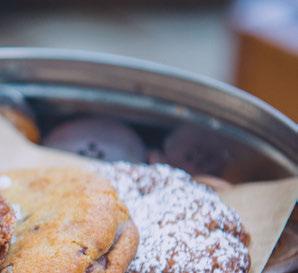
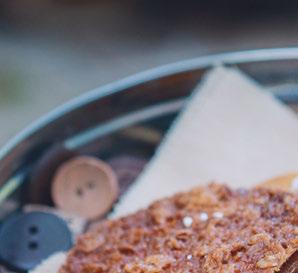
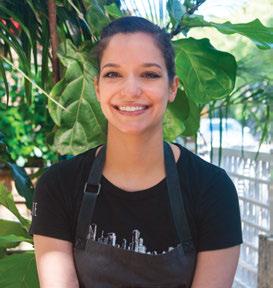
box? he t in s what'
by Amelia Schwartz
We’ve all been there (or seen it on Instagram lately): walking into Grandma’s house and spotting that blue tin of
Royal Dansk Danish Butter Cookies. Any kid would anticipate a sweet, buttery scent when opening the lid. But wait, what’s that? Buttons. String. Needles. Not a cookie in sight. ForPastry Chef Devin Braddock of Ariete
Hospitality Group, this disappointing childhood memory is especially poignant, so she reclaimed the cookie box with actual cookies. When guests order Grandma’s Cookie Tin at Ariete, they get the cookies they’ve always yearned for—and not even the semi-stale biscuits that Dansk provides. Sold together for $9, a trio of Braddock’s fresh-out-of-the-oven cookies, all with their own distinct eccentricities, is placed on a bed of buttons for a tongue-in-cheek twist. Here’s what’s in the cookie box:
Goat Cheese Oat Tuile
This variation of Little Debbie Oatmeal Creme Pies boasts a goat cheese frosting sandwiched between two steel-cut-oat wafers. The traditional creme pie’s chew is replaced with a satisfying snap, thanks to the cookies’ delicate exterior.
Sea Salt & Chocolate Chip
“[My cookie] is a play off of the Toll House recipe,” says Braddock. “I want it to be nostalgic but still restaurant-worthy.” Braddock packs the cookie with four different types of high-quality chocolate (from light to dark) and sprinkles sea salt over it in order to balance out the Toll House signature sweetness.
Pecan Blondie
Braddock uses a combination of caramelized white chocolate, sea salt, ginger, sugar (and a lot of it), and pecans for this ooey-gooey blondie cookie, fi nished with a dusting of powdered sugar.










